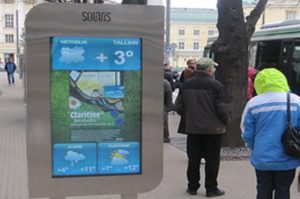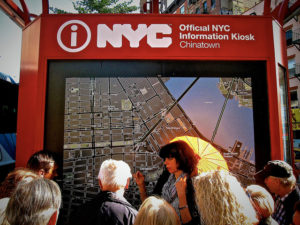Fourth, Fifth, Sixth Screen Experiences?
The number of digital out of home installations in the US has grown almost five times over since 2009, giving brands and media planners a new landscape to play in. While these are already great assets for expanding broadcast messaging, our team is more interested in how these digital out of home experiences provide the opportunity to add interactive features that produce high-value consumer experiences.

Digital out of home assets have the advantage of knowing one thing about their audiences that web platforms can struggle to understand: where they are. From that knowledge a wealth of valuable services, content, and, yes, media messages can be offered and we should expect to see more location based interactive digital screens in public spaces. From town squares, train stations, and airports, to hospitals, resorts, and retail stores we are just at the beginning of the digital out of home revolution.
Anyone who has visited the Ambility blog or scanned our post topics knows that our team is fairly obsessed with mobile screens and how we interact with them. But recently we’ve become obsessed with another kind of screen.
Digital out of home (DOOH) installations are undergoing a period of tremendous growth – from under 1.5MM screens in the US in 2009 to an estimated 7MM+ in 2015 according to Wirespring, a hardware connection platform provider. Hardware advances have increased both the quality of display and the durability of the devices, while increasing scale of development continues to decrease the
Hardware advances have increased both the quality of display and the durability of the devices, while increasing scale of development continues to decrease the
cost. Add to those factors the increase in media value that such placements enable above static media assets for owners of the physical spaces and we should expect to see dramatic increases in the number of screens we experience outside the home.
Beyond public spaces, expect to see more DOOH screens in office parks, schools, hospital complexes, and retail stores as well. Those spaces, too, are seeing dramatic increases in the number of digital screen installations driven by intense competition to enhance consumer/brand experiences.
Most out of home digital screens currently in use are broadcast experiences only that have immense media value but are limited in their ability to message individuals. Even the few direct response, large format screens in Times Square that allow you to post your selfie for all of midtown Manhattan to see are leveraging a pretty limited set of consumer needs: namely the need to broadcast your selfie to midtown Manhattan. Instead it’s a different kind of out of home digital screen that is getting the attention of the Ambility team: those screens that provide the potential for one-to-one or one-to-a-few interactions and can lead to highly personalized, high-value consumer experiences.
Location Based Connectivity
New York has undertaken a huge effort to replace its largely defunct collection of phone booths with a network of installations that offer WIFI connectivity, two large-scale display screens, and a third interactive screen. The interactive screen (an iPad) is housed just above waist level and includes a dedicated user interface providing access to city services (think 311 and 911) and free nationwide video calls. It’s this type of digital out of home screen that got us thinking.
Internet connectivity links us to billions of nodes of content and services at all times. But for now, at least, we are creatures capable of occupying only one physical space and one physical time. Data and design experts spend countless hours working to anticipate what we will want at any given time based on our demographic profile, browsing and purchase history, and our cohorts. But there is growing recognition that where we are when we’re outside the home or office is as much a determinant of what we are looking for as all of that profile information combined.
The things I’m looking for when I’m browsing the internet from my couch have almost no resemblance to what my wife and daughter are seeking, but when each of us is wandering around town at 1pm on a Sunday we’re probably looking for largely similar things: something to see, a place to eat, or a shop. If we each walk into a train station, hospital, or retail store the options are more limited still. In other words, the potential for digital out of home experiences to provide relevant, valuable messaging and services for even anonymous users is pretty high.
Interactive Digital OOH?
Large format digital displays that media planners covet have some inherent limitations in providing interactivity, but that could change. No one will look to book a restaurant reservation through a Times Square billboard but installations like the LinkNYC assets, transport information displays, or executions that leverage a small portion of a large display screen for interactivity could deliver broad access to more personalized location-based content. These in themselves would increase the media value of such installations (“Local Specials for You!!”), be great sources of insight for urban planners and marketers, and provide real value for consumers.
But I Already Have a Screen
To be sure, personal mobile devices are getting better and better at offering location-based custom content, but there are a multitude of reasons that location specific interactions offer advantages. Even ubiquitous platforms like Facebook and Google struggle to offer a consistent level of quality and detail, and well-designed displays that provide way-finding or other valuable content and services enhance a customer’s experience of a neighborhood, campus, or store.
Publicly accessible digital assets offer immediacy, all categories of local offerings at once (no switching between Open Table, Groupon, and local tourism board  offerings), and local attractions that tend to be featured on purely local online offerings. Municipal installations immediately become tourist information centers, educational campus installations become more comprehensive than any volunteer undergraduate guide, and hospital installations can tell you where radiology is and get you directions to the nearest pharmacy without taxing busy health professionals.
offerings), and local attractions that tend to be featured on purely local online offerings. Municipal installations immediately become tourist information centers, educational campus installations become more comprehensive than any volunteer undergraduate guide, and hospital installations can tell you where radiology is and get you directions to the nearest pharmacy without taxing busy health professionals.
Retail digital installations have the potential to broaden (or replace) shelf space and answer common consumer questions. No need to explain the difference between boot-cut, straight-leg, and skinny jeans when a digital screen can display it clearly. Paired with sensor technology, interactive screens can limit time in the changing room by showing how different items would look on the buyer.
If these same out of home interactive assets could somehow know our interests, our likes, our shoe size, without asking for someone to enter that detail then it could get really interesting.
Your Phone, Your Passport
It’s no secret that less than ten years after the release of the first iPhone the digital age has become fully mobile. Mobile now captures two out of every three digital minutes according to Comscore, and DMR reports that the Facebook mobile app has over 1.4 billion active monthly users. Through our likes, check-ins, and searches our smartphone has become one of the most intimate expressions of what we are interested in. And whatever our real passion points are, as the saying goes “there’s an app for that.”
The data that our phones collect have the potential to turn anonymous DOOH interactions into very targeted ones, and that need not be creepy. Explicit share requests that precede a near field communication interaction have the potential to be enormously valuable to visitors to a new city or a loyal shopper. My check-ins exhibit a pretty clear appreciation for water-front restaurants and cozy, old dive-bars. A customized itinerary for a new city based on those check-ins would be very welcome. And I know more than a few people who revel in discovering hidden specialty shops that match their interests. If they’re pushing a sale then all the better.
As the economics of DOOH continues to decrease the cost of installation, and targeting technologies provide additional media value to the dynamic screens expect to see more of these experiences. And don’t be surprised on your next trip to Paris if those famous old billboard kiosks can also direct you to that out of the way restaurant your friends told you about.

Your next screen?